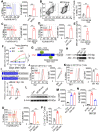FcγRIIB potentiates differentiation of myeloid-derived suppressor cells to mediate tumor immunoescape
- PMID: 34976216
- PMCID: PMC8692894
- DOI: 10.7150/thno.66575
FcγRIIB potentiates differentiation of myeloid-derived suppressor cells to mediate tumor immunoescape
Abstract
Background: FcγRIIB, the sole inhibitory receptor of the Fc gamma receptor family, plays pivotal roles in innate and adaptive immune responses. However, the expression and function of FcγRIIB in myeloid-derived suppressor cells (MDSCs) remains unknown. This study aimed to investigate whether and how FcγRIIB regulates the immunosuppressive activity of MDSCs during cancer development. Methods: The MC38 and B16-F10 tumor-bearing mouse models were established to investigate the role of FcγRIIB during tumor progression. FcγRIIB-deficient mice, adoptive cell transfer, mRNA-sequencing and flow cytometry analysis were used to assess the role of FcγRIIB on immunosuppressive activity and differentiation of MDSCs. Results: Here we show that FcγRIIB was upregulated in tumor-infiltrated MDSCs. FcγRIIB-deficient mice showed decreased accumulation of MDSCs in the tumor microenvironment (TME) compared with wild-type mice. FcγRIIB was required for the differentiation and immunosuppressive activity of MDSCs. Mechanistically, tumor cell-derived granulocyte-macrophage colony stimulating factor (GM-CSF) increased the expression of FcγRIIB on hematopoietic progenitor cells (HPCs) by activating specificity protein 1 (Sp1), subsequently FcγRIIB promoted the generation of MDSCs from HPCs via Stat3 signaling. Furthermore, blockade of Sp1 dampened MDSC differentiation and infiltration in the TME and enhanced the anti-tumor therapeutic efficacy of gemcitabine. Conclusion: These results uncover an unrecognized regulatory role of the FcγRIIB in abnormal differentiation of MDSCs during cancer development and suggest a potential therapeutic target for anti-tumor therapy.
Keywords: Fc gamma receptor IIB; Sp1 signaling; anti-tumor therapy; granulocyte-macrophage colony stimulating factor; immunosuppression; myeloid-derived suppressor cells; tumor microenvironment.
© The author(s).
Conflict of interest statement
Competing Interests: The authors have declared that no competing interest exists.
Figures







Similar articles
-
The impact of cytokines and tumour-conditioned medium on the properties of murine in vitro generated myeloid-derived suppressor cells.Scand J Immunol. 2025 Feb;101(2):e70001. doi: 10.1111/sji.70001. Scand J Immunol. 2025. PMID: 39865924
-
Regulation of ROS in myeloid-derived suppressor cells through targeting fatty acid transport protein 2 enhanced anti-PD-L1 tumor immunotherapy.Cell Immunol. 2021 Apr;362:104286. doi: 10.1016/j.cellimm.2021.104286. Epub 2021 Jan 19. Cell Immunol. 2021. PMID: 33524739
-
Fibrinogen-like protein 2 promotes tumor immune suppression by regulating cholesterol metabolism in myeloid-derived suppressor cells.J Immunother Cancer. 2023 Dec 6;11(12):e008081. doi: 10.1136/jitc-2023-008081. J Immunother Cancer. 2023. PMID: 38056898 Free PMC article.
-
Immunotherapy Targeting Myeloid-Derived Suppressor Cells (MDSCs) in Tumor Microenvironment.Front Immunol. 2021 Feb 4;11:585214. doi: 10.3389/fimmu.2020.585214. eCollection 2020. Front Immunol. 2021. PMID: 33613512 Free PMC article. Review.
-
Targeting Myeloid-Derived Suppressor Cells to Enhance the Antitumor Efficacy of Immune Checkpoint Blockade Therapy.Front Immunol. 2021 Dec 22;12:754196. doi: 10.3389/fimmu.2021.754196. eCollection 2021. Front Immunol. 2021. PMID: 35003065 Free PMC article. Review.
Cited by
-
Blocking soluble TNFα sensitizes HER2-positive breast cancer to trastuzumab through MUC4 downregulation and subverts immunosuppression.J Immunother Cancer. 2023 Mar;11(3):e005325. doi: 10.1136/jitc-2022-005325. J Immunother Cancer. 2023. PMID: 36889811 Free PMC article.
-
MDSCs in breast cancer: an important enabler of tumor progression and an emerging therapeutic target.Front Immunol. 2023 Jul 3;14:1199273. doi: 10.3389/fimmu.2023.1199273. eCollection 2023. Front Immunol. 2023. PMID: 37465670 Free PMC article. Review.
-
Therapeutic targeting of tumour-associated macrophage receptors.Immunother Adv. 2025 Mar 11;5(1):ltaf009. doi: 10.1093/immadv/ltaf009. eCollection 2025. Immunother Adv. 2025. PMID: 40385641 Free PMC article. Review.
-
Myeloid‑derived suppressor cells as targets of emerging therapies and nanotherapies (Review).Med Int (Lond). 2024 Jun 25;4(5):46. doi: 10.3892/mi.2024.170. eCollection 2024 Sep-Oct. Med Int (Lond). 2024. PMID: 38983795 Free PMC article. Review.
-
FcγRIIIA activation-mediated up-regulation of glycolysis alters MDSCs modulation in CD4+ T cell subsets of Sjögren syndrome.Cell Death Dis. 2023 Feb 6;14(2):86. doi: 10.1038/s41419-023-05631-4. Cell Death Dis. 2023. PMID: 36746935 Free PMC article.
References
-
- Liu CY, Wang YM, Wang CL, Feng PH, Ko HW, Liu YH. et al. Population alterations of L-arginase- and inducible nitric oxide synthase-expressed CD11b+/CD14(-)/CD15+/CD33+ myeloid-derived suppressor cells and CD8+ T lymphocytes in patients with advanced-stage non-small cell lung cancer. J Cancer Res Clin Oncol. 2010;136:35–45. - PMC - PubMed
-
- Diaz-Montero CM, Salem ML, Nishimura MI, Garrett-Mayer E, Cole DJ, Montero AJ. Increased circulating myeloid-derived suppressor cells correlate with clinical cancer stage, metastatic tumor burden, and doxorubicin-cyclophosphamide chemotherapy. Cancer Immunol Immunother. 2009;58:49–59. - PMC - PubMed
Publication types
MeSH terms
Substances
LinkOut - more resources
Full Text Sources
Molecular Biology Databases
Research Materials
Miscellaneous

